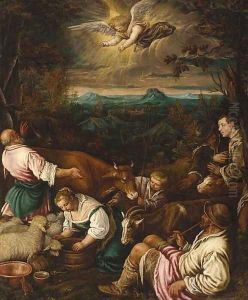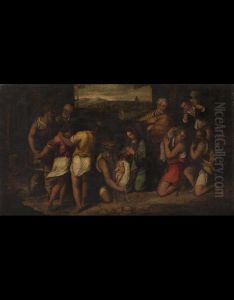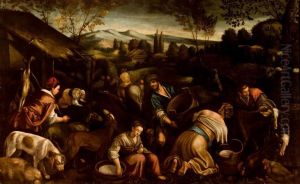Giambattista Da Ponte (Giambattista Bassano) Paintings
Giambattista da Ponte, also known as Giambattista Bassano, was an Italian painter who was born around 1510 in Bassano del Grappa, Veneto, Italy. He is often confused with his more famous son, Jacopo Bassano, but Giambattista himself was a significant figure in the Venetian school of painting. His work is less well-documented than that of his son, and as a result, his biography is intertwined with the artistic legacy of his family.
Giambattista was the progenitor of the Da Ponte painting dynasty, which included his sons, who were all trained in his workshop and became notable painters in their own right. His family took the name 'Da Ponte' from the town of Bassano del Grappa, which is characterized by a distinctive bridge ('ponte' in Italian). This name was to distinguish themselves from the numerous other artists in the region.
The artistry of Giambattista da Ponte was rooted in the Renaissance tradition. He absorbed influences from the Venetian masters of the time, such as Titian and Bonifacio Veronese. His style was characterized by its use of color and a certain robust, pastoral realism, which he passed on to his children. He was primarily known for his religious works and portraits, many of which were executed for local churches and patrons.
Giambattista's workshop was a hub of artistic activity and served as a training ground for his sons: Jacopo, Francesco, Giovanni Battista, and Leandro Bassano. Among them, Jacopo would go on to achieve the greatest fame, innovating in the use of color and light and contributing significantly to the development of the Venetian style.
The exact details of Giambattista da Ponte's career are scarce, and many of his works have been lost or are unattributed. However, his influence on his sons, especially Jacopo, is undeniable. Through his teaching and his workshop, he helped to establish a family legacy that would leave a lasting impression on the Venetian art scene.
Giambattista da Ponte passed away in 1592 in Bassano del Grappa. Despite the overshadowing fame of his offspring, Giambattista's role as the patriarch of a family that significantly contributed to the Venetian Renaissance should not be underestimated. His work and that of his sons are still studied and appreciated for their contributions to the rich tapestry of Italian Renaissance art.


